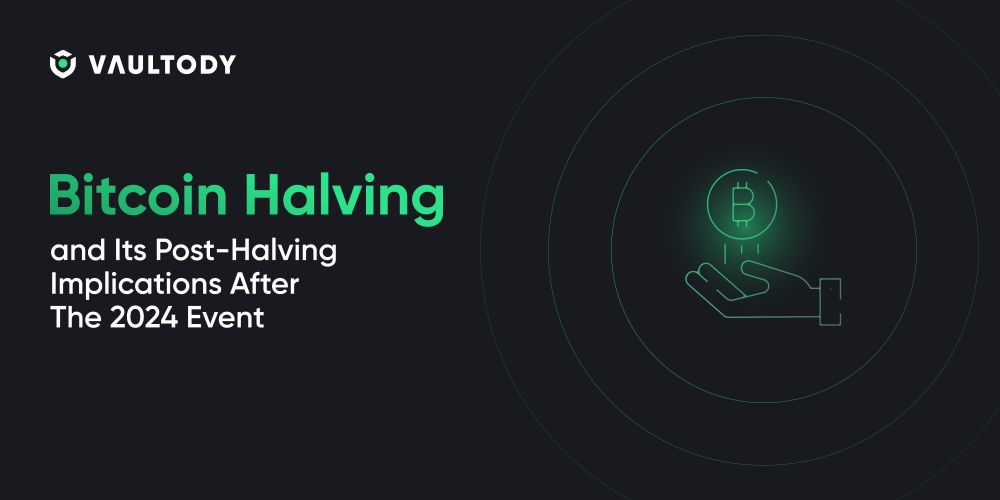To explain the Bitcoin halving, we need to be aware that Bitcoin (along with other blockchains) is based on the Proof-of-Work (PoW) mechanism, which allows cryptocurrency miners to take part in the network to validate transactions, and they get rewarded for their efforts. To participate in the network, miners must be equipped with special powerful computers that have the ability to solve difficult equations, allowing them to make contributions to the creation of new blocks and the release of coins into circulation.
Because of the PoW, the Bitcoin halving aim is to reduce by half the cryptocurrency miners' rewards on each halving event. This is a pre-programmed (set in Bitcoin`s smart contracts) event which happens approximately once each four years. Halvings are the perfect balancing mechanism, which controls the coin issuance and is aligned with the creator of Bitcoin, Satoshi Nakamoto`s capped total supply of 21 million Bitcoins.
How often Bitcoin halving occurs
We mentioned that halvings occur once every four years, but in reality, time is not the best metric, since there are certain conditions that must be met behind each event and they are not time-bounded. Satoshi Nakamoto stated in the Bitcoin whitepaper that halvings are happening once 210,000 blocks have been mined. We know that each BTC block takes around 10 minutes to be mined. Let's do some maths:
If one BTC block takes 10 minutes to mine, then 6 blocks are mined in an hour and 144 blocks in a day. Dividing the number of days by the blocks (210,000:144) yields approximately 1458.33 days. To find the number of years, we divide 1458.33 by 365 (the days in a year), resulting in 3.9954 years. This is why it is very common to come across claims that halvings occur roughly once every 4 years.
What are the consequences that Bitcoin halvings bring?
The 2024 Bitcoin halving is the fourth consecutive halving event. If we trace back the outcomes that were anticipated by the community during the last three events, we can easily identify two things. The first thing is concerned with Bitcoin`s price as there is a common acceptance that halvings affect the BTC price positively. The second is related to changes of the new amount that crypto miners will receive as rewards for their network input.
| Year | BТC block reward before halving | BТC block reward after halving | USD price on halving day | USD price 150 days later |
| 2012 | 50 BTC | 25 BTC | $12 | $127 |
| 2016 | 25 BTC | 12.5 BTC | $650 | $759 |
| 2020 | 12.5 BTC | 6.25 BTC | $8,820 | $10,943 |
| 2024 | 6.25 BTC | 3.125 BTC | $63,600 | Exp. Nov 2024 |
If we take a closer look at the table, we can observe a clear Bitcoin price pattern, showing price increases of the asset in the post-halving phase. This explains the expectations and predictions by the community the Bitcoin price will reach new all time highs. Will this happen again after the 2024 halving? The answer is that we can only speculate with the price of the asset and work with data that is available from the previous events, but in reality, only time will show which direction the BTC price will take.
As for the cryptocurrency rewards, there are not any doubts as halvings are always reducing the block reward by half, and this is outlined in the Bitcoin whitepaper by the Bitcoin creator. Even today, we can provide accurate details about the exact amount of block rewards for all upcoming halvings, for example the 2028 halving will reduce the block reward from the current 3.125 BTC to 1.5625 BTC.
Implications of the 2024 Bitcoin halving
It is too early to discuss how the 2024 halving will leave its mark over the long run as we are still in the month of the halving. However, the first activities that the market observed were a price dip driving the price under the $60,000 USD barrier for the first time in a 40-day period, which was then followed by an almost 5% price increase in the upcoming several days.
Similar price volatility was observed in previous halving events, which is associated with significant selling pressure from cryptocurrency miners as they make an attempt to maximize their earnings before the halving. The main driver for this selling pressure is the revenue decrease that miners usually experience post-halving. These activities are leading to price declines and increased volatility.
One of the most notable changes that was registered post 2024 halving was the very high transaction fees that were asked during the first couple days after the halving. The explanation for the unexpectedly high fees which caught users off guard are two: first, the natural adjusting mechanism for compensating the reduced rewards for miners; and second the release of the Runes protocol which aims to replace the existing Bitcoin ordinals. The use cases of the Runes will be to allow creating non-fungible tokens.
The Runes protocol launch allows node operators to perform inscriptions which is the process of adding data and images to new Bitcoin blocks. The inscriptions are similar to the non-fungible tokens (NFTs). With the introduction of Runes protocol, the demand for block space on the Bitcoin network is increasing, this affects network fees for BTC miners.
How the market will develop and in which direction the Bitcoin price and Bitcoin transaction fees will go is soon to be seen. In the meantime, regardless if you are using only Bitcoin or other cryptocurrencies, you can safely store and manage them with Vaultody through our multi-level security mechanisms and incredible flexibility that we provide to account owners. And if you are feeling uncomfortable paying high fees - then you are not alone, and our innovative Smart Vaults solutions can help you attain reductions of up to 90% on transaction fees. Contact our team for a personalized offer today.









 Copy link
Copy link